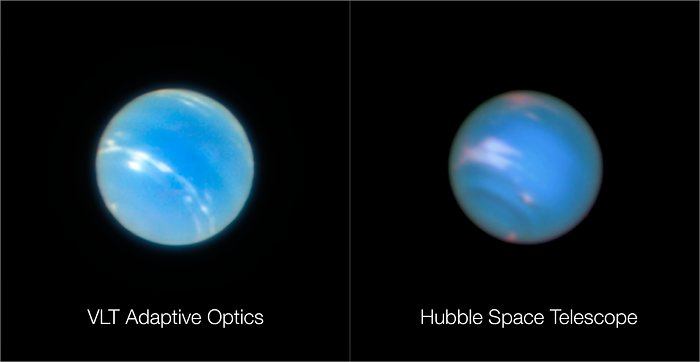Surprising cold on Neptune
Neptune, the outermost planet of our solar system, does not belong to the ice giants with its neighbor Uranus for nothing. The enormous distance to our central star ensures that the temperature out there falls below minus 200 degrees Celsius (-238 °F). Exactly how warm it gets depends, of course, on its current position in orbit. However, distinct seasons are not really to be expected: Neptune has an almost circular orbit, so it only moves away from or comes close to the Sun minimally, and at the same time it stands on this orbit with a very low axial inclination, while the Earth is inclined by 23.5 degrees. With an annual length of 165 years, each season on Neptune lasts about forty years. Since 2005 it is winter in the north and summer in the south.
Astronomers at the European Southern Observatory (ESO), who have been tracking temperatures in Neptune’s atmosphere over a 17-year period, were all the more surprised. Namely, they found a surprising drop in Neptune’s global temperatures while its south pole warmed dramatically. “This change was unexpected,” says Michael Roman, a research associate at the University of Leicester, U.K., and lead author of the study, published in The Planetary Science Journal. “Because we observed Neptune during its southern early summer, we expected temperatures to slowly increase, not decrease.”
The scientists and researchers examined nearly 100 thermal images of Neptune taken over a 17-year period to track the overall evolution of the planet’s temperature in more detail than ever before. These data show that most of the planet has cooled gradually over the past two decades, despite the southern summer. Neptune’s global average temperature dropped 8 °C between 2003 and 2018. Astronomers were equally surprised to discover a dramatic warming of Neptune’s south pole in the last two years of their observations, with temperatures rising rapidly by 11 °C between 2018 and 2020. Although Neptune’s warm polar vortex has been known for many years, such rapid warming of the pole has never before been observed on the planet.
Because Neptune’s temperature swings were so unexpected, researchers don’t yet know what might have caused them. They could be due to changes in Neptune’s stratospheric chemistry, random weather patterns, or even the solar cycle.

